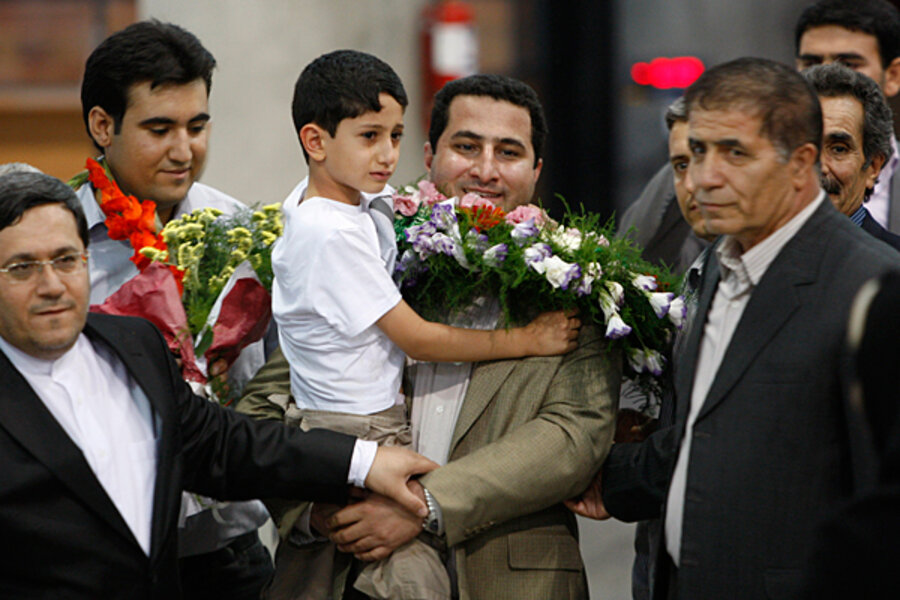Iran nuclear defector: Three reasons he might have gone back
Loading...
| Washington
The return of Iranian scientist Shahram Amiri to his homeland raises an obvious question: Why would a defector go back?
US officials say Amiri was a willing recruit who provided US intelligence with information about Iran’s nuclear program. In return, he was paid $5 million –though he couldn’t take that money with him when he flew back to Tehran this week.
Amiri himself says he was kidnapped while in Saudi Arabia in June 2009. That’s certainly possible but, generally speaking, people in CIA custody don’t manage to post videos on YouTube complaining about their plight, as did Amiri.
So what happened? Amiri the defector (if that’s truly what he was) proved himself to be a complicated human being.
People turn against their countries for a volatile stew of reasons, including anger, ambition, and disillusionment. It’s easy for that mix to keep simmering and change its nature after the flight from the homeland has been accomplished.
Recent CIA experience shows a number of reasons why such change, over time, can result in redefection.
A failure to recruit. This may seem odd – isn’t the defector already here? Why would his (or her) handlers have to continue to lure their catch in? But the fact is, if US intelligence does not keep selling to the defector the advantages of his new state, he or she may grow dissatisfied.
Perhaps that is why Vitaly Yurchenko went back. Yurchenko was a KGB officer who defected to the US during an assignment to Rome in 1985. A few months later, he fled back to the USSR. At a 1999 academic conference, former deputy CIA counterintelligence chief Paul Redmond complained that the agency had treated Yurchenko like an asset to be squeezed. Everybody in the intelligence community wanted to ask him questions. They even wanted to know if he knew the whereabouts of Swedish humanitarian Raul Wallenberg, who was thought to have disappeared while in Soviet custody.
“We didn’t recruit him, therefore we could not help him personally get through the problems of adjustment here,” said Mr. Redmond at a conference on intelligence and the cold war presided over by former President George H.W. Bush.
The human factor. It’s possible Amiri did not like it in the US. Maybe his expectations, shaped by Hollywood’s products, were too high. Maybe guilt overcame him. Maybe he missed his wife and son too much. Generally, the CIA tries to extract a defector’s family with them; why that did not happen in this case remains a mystery.
The aforementioned Vitaly Yurchenko had lots of personal problems, noted his former KGB boss, Oleg Kalugin, at the 1999 conference, which brought together intelligence professionals from both sides of the old Iron Curtain. Yurchenko was chronically ill and had overly optimistic expectations for Western medicine, according to Mr. Kalugin. He also had a mistress, a Soviet national posted at an embassy in Canada, whom he unsuccessfully tried to get to defect with him.
“For him it was a major personal loss. He really was in love with her,” said Kalugin.
The preplanned return. A final possibility is that Amiri was a plant, a double agent. He was sent here to mislead the US by planting intelligence that had enough truth in it to be accepted, but was distorted in important ways. That happens in spy thrillers – and it happens in real life, too.
Many top US officials from the 1980s believe Yurchenko was a plant, for instance. Yes, he exposed NSA analyst Ronald Pelton and CIA case officer Edward Lee Howard, who were spying for the Soviet Union. But for a time this may have taken the attention of US officials away from a far more damaging mole: CIA counterintelligence officer Aldrich Ames.
As for Amiri case, it is now an intelligence operation with many layers, only a few of which are apparent to the public eye. The truth about his actions may not be known for years, if ever. If nothing else, Amiri has revealed that John LeCarré had it right: Intelligence operations are carried out in a world of gray.
Related:





